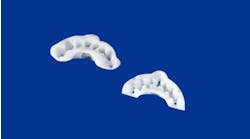A Peer-Reviewed Publication Written by Yan-Fang Ren DDS, PhD, MPH
Abstract
Dental erosion is a prevalent condition that occurs worldwide. It is the result of exposure of the enamel and dentin to nonbacterial acids of extrinsic and intrinsic origin, whereby mineral loss occurs from the surface of the tooth. The most frequently affected areas are the palatal surface of maxillary incisors and the occlusal surface of the mandibular first molars in adolescents. Characteristic early signs of dental erosion include smooth and flat facets on facial or palatal surfaces, and shallow and localized dimpling on occlusal surfaces. Early intervention is key to effectively preventing erosive tooth wear. Effective prevention of dental erosion includes measures that can avoid or reduce direct contact with acids, increase acid resistance of dental hard tissues and minimize toothbrushing abrasion.
Educational Objectives:
At the end of this self-instructional educational activity, the participant will be able to:
1. List and describe the prevalence of dental erosion
2. List and describe the etiologies of dental erosion
3. List and describe the signs and symptoms of dental erosion and the complicating factors associated with dental erosion
4. List and describe methods for the management and prevention of dental erosion
Author Profile
Yan-Fang Ren DDS, PhD, MPH is an Associate Professor in the Division of General Dentistry at the University of Rochester Eastman Institute for Oral Health. Dr. Ren can be reached at [email protected].
To view this course in its entirety, please click here.
Past RDH Issues





